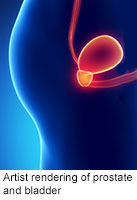Increased likelihood of prostate cancer seen with fourth repeat biopsy, men ≥70
MONDAY, April 13, 2015 (HealthDay News) — Among a group of men with an initial negative prostate biopsy, clinically significant cancer is still found in subsequent repeat sampling rounds, according to a study published in the April issue of The Journal of Urology.
Nitya E. Abraham, M.D., from the New York University School of Medicine in New York City, and colleagues collected data on 1,837 men who underwent prostate biopsy (Jan. 1, 1995, to Jan. 1, 2010). The authors sought to determine characteristics of repeat biopsy (indication for biopsy, the number of repeat biopsies performed, the number of cores obtained, and total prostate-specific antigen before biopsy), as well as features of prostate cancer diagnosed on repeat biopsy (including Gleason score, number of positive cores, percent of tumor and treatment choice).
The researchers found that 1,213 men had negative initial biopsies, but that 798 repeat biopsies were performed in 255 men. Gleason score was ≤6 in 33 of 63 men diagnosed with prostate cancer, 7 in 22, and 8 to 9 in eight. Using Epstein criteria, the rate of clinically insignificant cancer diagnosis decreased substantially by the third and fourth repeat biopsies. An increased likelihood of prostate cancer diagnosis was seen in men ≥70 years with repeat biopsies, biopsies including more than 20 cores, and the fourth repeat biopsy.
“Given the continued likelihood of cancer detection even by the fifth biopsy, early consideration of saturation or image guided biopsy may be warranted in the repeat biopsy population,” the authors write.
One author disclosed financial ties to the pharmaceutical and medical device industries.
Copyright © 2015 HealthDay. All rights reserved.








